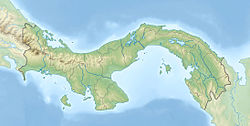| Tuira Formation | |
|---|---|
| Stratigraphic range: Tortonian (Clarendonian-Hemphillian) | |
| Type | Formation |
| Location | |
| Coordinates | 8°30′N77°42′W / 8.5°N 77.7°W |
| Approximate paleocoordinates | 8°12′N76°18′W / 8.2°N 76.3°W |
| Region | Darién Province |
| Country | Panama |
| Type section | |
| Named for | Tuira River |
The Tuira Formation is a geologic formation in Panama. It preserves bivalve, gastropod and sponge fossils dating back to the Tortonian period (Clarendonian to Hemphillian in the NALMA classification), from 11 to 9.5 Ma. [1] [2]
